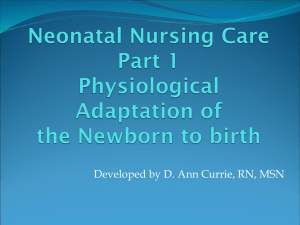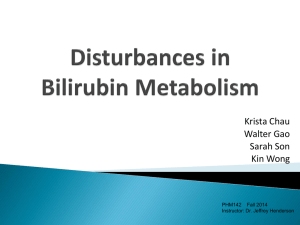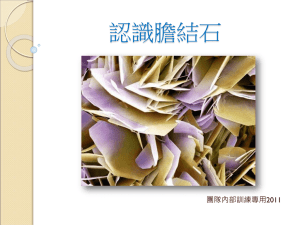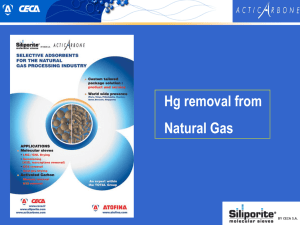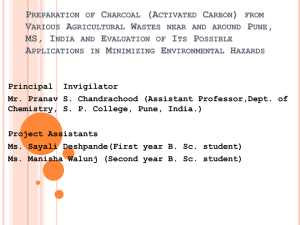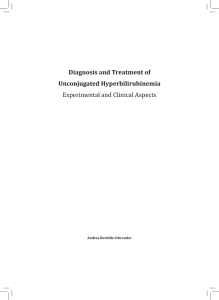Extracorporeal_Sorbents_ESAO_2007
advertisement
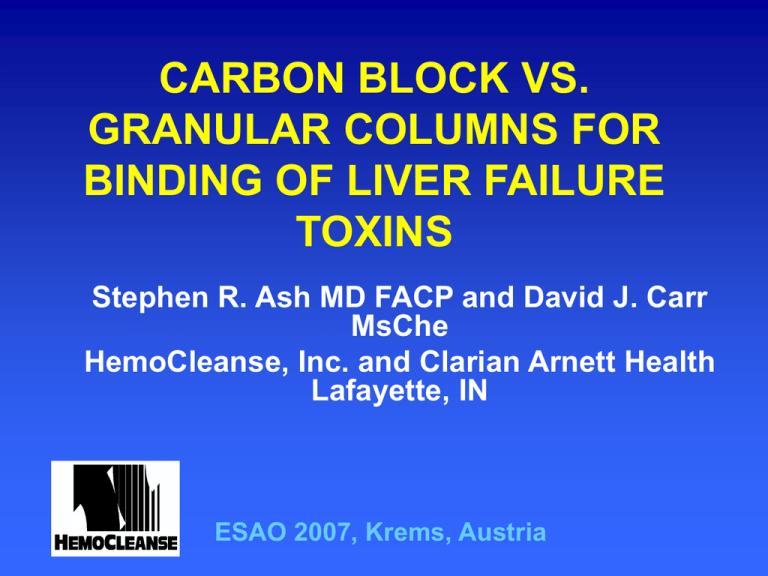
CARBON BLOCK VS. GRANULAR COLUMNS FOR BINDING OF LIVER FAILURE TOXINS Stephen R. Ash MD FACP and David J. Carr MsChe HemoCleanse, Inc. and Clarian Arnett Health Lafayette, IN ESAO 2007, Krems, Austria The Problem • • • Capacity for high molecular weight and protein-bound toxins has limited carbon’s efficacy in extracorporeal therapy (and other sorbents). Most of the active carbon surface in granules is in the interior, hidden from the flowing stream and protein-bound toxins. Small particle size allows direct interaction of sorbents with macromolecules and bound toxins. However, particles of 1-10 microns are impossible to directly fabricate into columns. Sorbent suspensions are difficult to retain during convection at membranes. 2 Adsorption Background Transport Processes Adsorption Processes Bulk Convection Aggregation Axial Dispersion Adsorption Film Diffusion Denaturation Pore Diffusion Interference Surface Diffusion Solid Phase Reaction 3 Adsorption Processes Diagram Bulk Fluid Bulk Convection Aggregation Axial Dispersion Film Diffusion Adsorption Sites Adsorption Pore Diffusion Denaturation Interference Surface Diffusion Pore Fluid Sorbent Particle Solid Phase Reaction Diagram courtesy Dr. N.-H. L. Wang 4 Micropores vs. Mesopores 5 Using sorbent regeneration avoids need for large amounts of plasma and sterile replacement fluid, making the system easier to implement and control... 6 But if the sorbents saturate, there is decreasing clearance of hepatic toxins during the treatment. Example: decreasing clearance of bilirubin over time in the MARS system (partly due to column saturation): 7 Further evidence for sorbent capacity limitations PrometheusTM : “Blood clearances of protein-bound toxins decrease over time. The rate and the efficiency of removal of albumin-bound toxins are interrelated to both the strength of the albumin binding and the saturation of the adsorption columns” (Cl tB 29.3 ± 5.1 vs. 13.7 ± 3.7) *P. Evenepoel, Y. Vanrenterghem et al., Detoxifying Capacity and Kinetics of Prometheus® - A New Extracorporeal System for the Treatment of Liver Failure , Blood Purification 8 Our Project Goals: • Develop method of screening sorbents for detoxification applications to predict removal of small and protein-bound toxins. • Compare efficacy of toxin removal by mesoporous carbons in several physical forms. 9 Activated Carbons Tested Description Surface Area, m2/gram Bulk Density, g/mL Maxsorb Pellets 1.5mm diameter 2,060 0.31 Maxsorb Powder 25 to 75 μm 2,060 0.31 Powder, 1 to 25 μm 1,700 0.22 Norit C Gran: 840 -1,700 μm 1,400 0.20 Preliminary Study Norit A Granular HSGD Synthetic beads, 100 -1,000 μm ~1,600 0.10 Block Immobilized powder 1,300 0.41 Nanofiber Immobilized powder 800 0.21 10 HSGD 500 microns 10.0 microns 50 microns 2.0 microns 1.0 microns Micrographs courtesy Dr. VG Nikolaev 11 Maxsorb Pellets Carbon Block Nanofiber 12 Preliminary Study Bilirubin adsorption of two carbons with similar surface areas was compared as a function of particle size. Maxsorb carbon is commercially available in pellets. It was tested as pellets and as powder after grinding in a mortar and pestle and sieving. Equilibrium binding of bilirubin in 5% albumin was tested for these carbons. Initial [bilirubin] was up to 12 mg/dL. 13 Bilirubin Adsorption by Activated Carbon Powdered vs. Granular Bilirubin in 5% albumin at 37C Amount Bound, mg / g carbon 1.6 1.4 1.2 1.0 0.8 0.6 0.4 0.2 0.0 0.0 1.0 2.0 3.0 4.0 5.0 6.0 7.0 8.0 9.0 10.0 Equilibrium Concentration, mg bilirubin / dL Norit Powder Maxsorb Powder Maxsorb Pellets 14 Results of Preliminary Study Langmuir coefficients for bilirubin Maximum Capacity, mg/g carbon Maxsorb Pellets Maxsorb Powder Norit A Relative Capacity Binding Constant, mL/mg bilirubin Relative Binding Constant 0.069 1 32.8 17.4 3.5 51 1.9 1.0 20.7 300 4.0 2.1 Powdered carbons had much higher bilirubin capacity than granular carbon. 15 Materials & Methods Activated carbons were tested as powders in mixed suspension and as columns of beads or immobilized particles. Test conditions were scaled from human clinical application. Isothermal adsorption of 3 compounds from aqueous solution at low concentration (50-100 ppm) was used as a screening criterion: methylene blue (MW 320), albumin (MW 66,000) and blue dextran (MW 2,000,000). Three carbons with the highest large-molecule adsorption were tested in columns. Adsorption at 37°C and constant pH of bilirubin (MW 585) or cytokines (IL-1β, IL-6, & IL-10) from plasma was tested in a system that recirculated treated plasma to a tank simulating a patient for 10 hours. Removal efficiency is the final toxin concentration in the tank is expressed as a percentage of the initial tank 16 concentration. Results: Binding of Marker Molecules Methylene Blue Removal Efficiency Initial [Methylene Blue] = 50 ppm 100% Methylene Removal % 90% 80% 70% 60% 50% 94.04% 95.33% 99.22% Granular HSGD Block 40% 30% 20% 10% 0% Activated Carbon 17 Results: Binding of Marker Molecules Albumin Removal Efficiency Initial [Albumin] = 50 ppm 100% Albumin Removal % 90% 80% 70% 60% 50% 94.13% 99.85% 40% 30% 20% 10% 19.10% 0% Granular HSGD Block Activated Carbon 18 Results: Binding of Marker Molecules Blue Dextran Removal Efficiency Initial [Blue Dextran] = 100 ppm 100% Blue Dextran Removal % 90% 80% 70% 60% 55% 46% 50% 40% 30% 20% 16% 10% 0% Granular HSGD Block Activated Carbon 19 Results: Binding of Bilirubin Bilirubin Removal Efficiency Initial [Bilirubin] = 4 mg% 100% 90% Bilirubin Removal % 80% 70% 67% 66% HSGD Block 60% 50% 40% 30% 30% 20% 10% 0% Nanofiber Activated Carbon Granular carbon=near zero 20 Results: Binding of Cytokines Cytokine Removal Efficiency Single Cytokine in 5% Albumin 100% Cytokine Revmoval % 90% 80% 80% 73% 70% 59% 60% 50% 59% 49% 40% 33% 35% 29% 30% 20% 11% 10% 0% Nanofiber HSGD Block Activated Carbon IL-1β Granular carbon=near zero IL-6 IL-10 21 Results Summary •Methylene blue performance is similar for all the carbons tested. •Carbon adsorbs blue dextran in proportion to its mesoporous character AND to the surface area exposed to flowing fluid. •Carbons with significant blue dextran interaction also remove bilirubin and cytokines from plasma. •Carbon block (powdered) removes bilirubin and cytokines about as well as HSGD, the best clinically tested carbon. 22 Carbon Comparison Carbon Block HSGD Nanofiber Carbon Density +++ ++ + ++ Lack of Fines +++ -- ++ -- Small Toxin Capacity +++ +++ +++ +++ Bilirubin Capacity +++ +++ + + Cytokine Capacity ++ +++ ++ + - With coating Hemoperfusion capable Additional sorbent capable + +++ - ++ Granular 23 Conclusions • Blue dextran adsorption from aqueous solution is indicative of in-vitro bilirubin and cytokine binding capacities. • Mesoporous carbons with high surface area in contact with flowing fluid are the best candidates for clinically effective sorption of protein-bound toxins. • Examples are HSGD and carbon block (pore size range = 2 to 50 nanometers) • For reasons of density, lack of fines, flexibility, carbon block is a practical and effective choice. 24 Progress towards Carbon Block for Biological Fluid Regeneration • Carbon type, particle size, and size of block • Purity of perfusate-AANSI standards for metals, endotoxin, bacteria • Free of organics-GCMS assay • Case design • Sterilization of product • Priming with sterile fluid • Platform definition-regenerate dialysate, then albumin-dialysate and plasma. 25 Alternative Carbon to Consider: carbide-derived carbon 26 Once the artificial liver is built, how to test it? Rats! Peritoneal implants 107 Cells in membranes 27 Sorbent-Based Pheresis in the Rat Plasmafilter and Sorbent Reactors Animal Interface Hydraulic Performance Rat Blood and Plasma Treatment Volumes 700 600 Volume Treate d (mL) 500 400 300 200 100 0 5B 7B 40B 50B 52N 56N 60N 58N 52V 43V 44V 49V Rat Number Blood Volume Treated mL) Plasma Volume Treated (mL) 51V 55V 61V 63V Blood cellular and chemical component tests Figure 14 Average IL-1b Treated vs Control 900 800 Figure 12 700 Average WBC Treated vs Control 600 pg/ml 30 400 300 200 20 100 0 4 ay 3 D ay D tr ti Ea n rl y tr to ut La te tr ti La n te tr to ut Pr etr t Ps t- 10 Ea rl y Pr edo se do se 2h 15 tim e/day 5 P= 0.89 Treated Control 0 day 4 Figure 15 Average IL-10 for Treated vs Control Anim als 1400 1 rat 1200 P= 0.2 1000 800 600 P= 0.1 400 200 0 P= 0.0 -200 Day 3 Control Late trt b Treat Late trt a day 3 Early trt b day 2 Early trt a post-trt time/day Pre-trt pre-trt Pst-dose2h post-dose 2h Pre-dose pre-dose IL-10 concentration, pg/mL WBC Count, 1000 / uL 25 500 Tim e Treated Control 32 Treatment Results include survival to death or euthanasia by defined criteria Average survival in hours 140.00 120.00 Hours 100.00 80.00 60.00 40.00 20.00 0.00 Treated Control Pheresis with sorbents and/or cells is possible for a rat liver failure model 34 Artificial liver support therapy for patients with fulminant hepatic failure currently used in Japan- TAD, Yoshiba et al. 35 36 37 Evidence for sorbent capacity limitations MARS : The removal efficiency of albumin-bound toxins drops after the initiation of treatment to become insignificant after 6 hours due to both the strength of the albumin binding and the saturation of the adsorption columns* *P. Evenepoel, Y. Vanrenterghem et al., Detoxifying Capacity and Kinetics of the Molecular Adsorbent Recycling System Contribution of the Different Inbuilt Filters, Blood Purification 38 39 40


